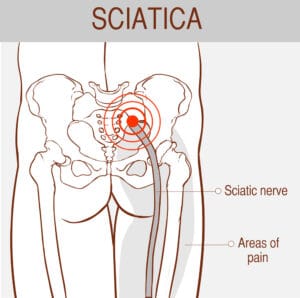You are a very active person. You run, you hike, you do weight training, and then you get sciatica. Oh no!!!
WAIT! Not to worry! We are here to give you a brief overview of what sciatica is, and what you can do on your own to help decrease symptoms and even prevent it. While sciatic pain symptoms can range from mild to practically debilitating we need to know what it is and what we can do for it.
Below is some brief info about Sciatica.
Sciatica is seen as a nerve irritation to the sciatic nerve. The origin of the sciatic nerve begins from nerve roots from the L4-L5 and S1-S3. It is composed of two separate groups of nerves before becoming the sciatic nerve, they are the tibal and common fibular nerve branches, named after the locations that they will supply at the lower extremity.
As the sciatic nerve travels down the back side of the hip and lower into the thigh and behind the knee it is in constant contact with several muscles and boney surfaces. Consider the path it travels on as a gauntlet, meaning these structures can be seen to adhere to the nerve and cause a “tightness” sensation.
One of the most popular conditions is called the Piriformis Syndrome. This can be a nagging chronic condition that may even present as a low back pain condition, ie, disc related issue.
If the piriformis muscle(pictured below) is the culprit, the continued tension in the muscle will lead to a neurogenic ischemia. This means the nerve is being blocked from via pressure, and like we said above nerves do not do well with increased pressure or stretch.

Independent of your sport or activity a sciatic related condition causing symptoms can limit you quickly. These symptoms may not feel like a loss of strength, but can definitely prevent you from a regular training schedule. And that is not good for someone with a set schedule in training.
In assessing for sciatica or piriformis syndrome there are a few staple orthopedic tests that can/should help inform the clinician on diagnosis and prognosis.
Here are a few tests that may be considered in your assessment:
Posture: an exaggerated posture “could” be a contributor to your symptoms.
Range of Motion: it is important to know what movements are pain free, but active and passive range of motions are examined both in the low back and the hips.
Palpation: this is the hands on assessment of joints and tissue. Inflamed tissue does feel different and can be helpful in determining a diagnosis. This is also important why addressing treatment and assessment over each visit.
Orthopedic tests: Lumbar spine end range movements. With this the goal is ruling out any spine related conditions.
Neural Tension Tests: Slump Test, Straight Leg Raise
Treatment of Sciatica using conservative modalities may involve myofascial release of the tissue surrounding the sciatic nerve, manipulation to the low back and pelvis. Post treatment exercises may include movements that include nerve flossing to the sciatic nerve. Strengthening of the lumbar spine and pelvis. Watch for more exercise videos to be shared shortly. Follow along on our youtube channel to stay up to date with our newest videos coming out. Click link below to subscribe
The grand goal of treatment is to get you feeling better than before starting treatment. It is also the goal of becoming more resilient. We incorporate methods of strength training into your treatment plan to build that resiliency. It is of my opinion that strength training has the capacity to help with the minor aches and pains and also builds a self efficacy in many different positions that you can put your body in on any given day. It is about expanding our movement library to feel better.
A collegue of mine in Colorado put together this warm up for the hamstrings to help limit or prevent sciatic symptoms. Click here to receive it. Follow Dr. Adam Axmear for more great content at human-movement-clinic.com
For more information follow this video on one way to begin building that movement library.